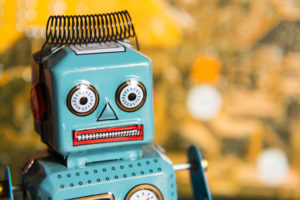
Wrapping our Heads Around CES 2023 and Next Generation Applied AI

(Kobby Dagan/Shutterstock)
CES has evolved from its Consumer Electronics roots to being a far more complex show that is somewhat reminiscent of Comdex. This means that, often, the first appearance of a new technology that will initially or eventually move into the enterprise shows up at CES. (Unfortunately, the show comes at the beginning of January and messes up the holiday vacations of those that have to prepare for it.) This year, the AI announcements showcased a clear focus on improving productivity in areas ranging from the creation of automated factories, to the training and management of robotic fleets, to both graphics design and authoring.
Without mentioning the vendors, let’s talk about what some of these AI announcements will mean for our increasingly automated future.
AI As a Helper or Rival
One of the things we’ll have to wrap our arms around is whether AI will fully emerge as a technology that enhances or replaces us. At CES this year, most of the advanced AI technology I saw enhanced rather than replaced people. However, when you have severe labor shortages like our industry is weathering, there is a growing trend to move to replacement given there aren’t enough workers to enhance at the moment.
One of the areas getting the most focus is the food industry where the labor shortage is forcing stores to close for lack of staffing. In this industry, robots are more expensive to deploy than people, but if you can’t get the people, then the choice is whether you can even do business, and that could force a robotic replacement strategy. It is interesting to note that it is the fry station that is getting the most attention because, apparently, that is where the most injuries result.
End-to-end Virtualization in the Metaverse
Showcased at the event was the first end-to-end metaverse tool set that would help with the creation of the physical factory building, the design and layout of the manufacturing lines, the pre-training and simulation of the robotic manufacturing process, the design and training of AI-operated products, and the AI management of the entire facility and eventually the products it produces.
The metaverse is used to first conceptualize both the factory and the products it creates, test both in simulation so problems can be addressed before either is built, and then overlay a management utility that manages both separately, which minimizes labor and advances the broad use of AI significantly. It wouldn’t take a huge leap to imagine a future where a factory created and run by AIs builds new AIs without any human being involved in the process. In effect, we are seeing the beginning of a path to AI reproduction which could have interesting implications about our future.
AI-Generated Content
One of the demonstrations was the use of metaverse tools to create a shortform animated movie in real time during the pitch. A team of employees using a variety of interlinked creation tools created the characters, set, story line and finished product in about the same time it took me to write this paragraph, arguably making older approaches like story boards obsolete. Upscaling the result with future technology could result in a finished photorealistic product that allows a small team of individuals to create a movie that looks like it has live action but instead uses avatars that look like real people. From conception to finished product, the result would cost a tiny fraction of what a similar movie today would cost using animators and live actors. ChatGPT, an OpenAI offering, is already showcasing how songs, stories and even books can be created by AI. Tools to create professional-looking art from rough drawings from non-artists was another highlight of the initial announcements.
Finally, for broadcasters, improvements to how AI could enhance how you appear on screen were showcased effectively suggesting a time when you could appear on Zoom perfectly turned out even though you were actually in your PJs because you just got out of bed (not that this has ever happened to me).
Wrapping up:
CES continues to evolve from a Consumer Electronics event to one that covers a far broader use of technology, including in the enterprise. AI is now the most obvious demonstration of this change and shows us how future and ever more intelligent products will be conceived by AIs that will also conceive the related factories and design the production lines. AIs will even produce and evolve the products the factory makes over time, effectively introducing AI reproduction capabilities.
While most of what I saw at CES enhances rather than replaces people, there is a clear and growing trend to flip to replacement due to the severe labor shortages plaguing many industries. So, while this show is another step in the birth of general purpose AIs, it is also potentially the sunsetting of many existing jobs and employees.
CES was fascinating and just a little scary this year when it came to AI advancement. 
About the author: As President and Principal Analyst of the Enderle Group, Rob Enderle provides regional and global companies with guidance in how to create credible dialogue with the market, target customer needs, create new business opportunities, anticipate technology changes, select vendors and products, and practice zero dollar marketing. For over 20 years Rob has worked for and with companies like Microsoft, HP, IBM, Dell, Toshiba, Gateway, Sony, USAA, Texas Instruments, AMD, Intel, Credit Suisse First Boston, ROLM, and Siemens.
Related Items:
AI Expected to Make Big Splash at CES 2023
In the Shadow of the Twitter Acquisition-Layoff Disaster: How to Prepare for Layoffs
The Need to Refocus AI Priorities
April 26, 2024
- Google Announces $75M AI Opportunity Fund and New Course to Skill One Million Americans
- Elastic Reports 8x Speed and 32x Efficiency Gains for Elasticsearch and Lucene Vector Database
- Gartner Identifies the Top Trends in Data and Analytics for 2024
- Satori and Collibra Accelerate AI Readiness Through Unified Data Management
- Argonne’s New AI Application Reduces Data Processing Time by 100x in X-ray Studies
April 25, 2024
- Salesforce Unveils Zero Copy Partner Network, Offering New Open Data Lake Access via Apache Iceberg
- Dataiku Enables Generative AI-Powered Chat Across the Enterprise
- IBM Transforms the Storage Ownership Experience with IBM Storage Assurance
- Cleanlab Launches New Solution to Detect AI Hallucinations in Language Models
- University of Maryland’s Smith School Launches New Center for AI in Business
- SAS Advances Public Health Research with New Analytics Tools on NIH Researcher Workbench
- NVIDIA to Acquire GPU Orchestration Software Provider Run:ai
April 24, 2024
- AtScale Introduces Developer Community Edition for Semantic Modeling
- Domopalooza 2024 Sets a High Bar for AI in Business Intelligence and Analytics
- BigID Highlights Crucial Security Measures for Generative AI in Latest Industry Report
- Moveworks Showcases the Power of Its Next-Gen Copilot at Moveworks.global 2024
- AtScale Announces Next-Gen Product Innovations to Foster Data-Driven Industry-Wide Collaboration
- New Snorkel Flow Release Empowers Enterprises to Harness Their Data for Custom AI Solutions
- Snowflake Launches Arctic: The Most Open, Enterprise-Grade Large Language Model
- Lenovo Advances Hybrid AI Innovation to Meet the Demands of the Most Compute Intensive Workloads
Most Read Features
Sorry. No data so far.
Most Read News In Brief
Sorry. No data so far.
Most Read This Just In
Sorry. No data so far.
Sponsored Partner Content
-
Get your Data AI Ready – Celebrate One Year of Deep Dish Data Virtual Series!
-
Supercharge Your Data Lake with Spark 3.3
-
Learn How to Build a Custom Chatbot Using a RAG Workflow in Minutes [Hands-on Demo]
-
Overcome ETL Bottlenecks with Metadata-driven Integration for the AI Era [Free Guide]
-
Gartner® Hype Cycle™ for Analytics and Business Intelligence 2023
-
The Art of Mastering Data Quality for AI and Analytics
Sponsored Whitepapers
Contributors
Featured Events
-
AI & Big Data Expo North America 2024
 June 5 - June 6Santa Clara CA United States
June 5 - June 6Santa Clara CA United States -
CDAO Canada Public Sector 2024
 June 18 - June 19
June 18 - June 19 -
AI Hardware & Edge AI Summit Europe
 June 18 - June 19London United Kingdom
June 18 - June 19London United Kingdom -
AI Hardware & Edge AI Summit 2024
 September 10 - September 12San Jose CA United States
September 10 - September 12San Jose CA United States -
CDAO Government 2024
 September 18 - September 19Washington DC United States
September 18 - September 19Washington DC United States




























